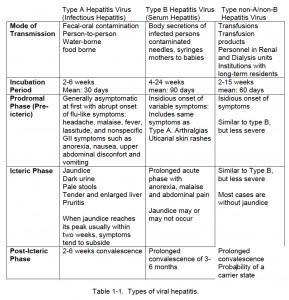a. Type A hepatitis virus, also called infectious hepatitis, is a highly contagious form of hepatitis. Modes of transmission include:
(1) Oral ingestion of contaminated materials such as water, milk, or shellfish from contaminated waters.
(2) Fecal/oral contamination from poor sanitation.
(3) Person-to-person contamination from blood, saliva, or feces.
(4) Blood transfusions are RARELY, if ever, a source of Type A hepatitis virus.
b. Type B hepatitis virus, known as serum hepatitis, is the type that poses a threat to health care workers. Type B hepatitis virus is spread through:
(1) Contact with contaminated body secretions.
(2) Parentally, through contact with contaminated needles, syringes, blood, and blood products.
(3) By transmission from mothers to babies.
c. A third type of hepatitis virus is identified as type non-A/non-B. Although the cause for this type of hepatitis is unclear, its mode of transmission appears to be blood-borne. Type non-A/non-B hepatitis virus is responsible for 80 percent—90 percent of all the post transfusion cases of hepatitis. It is associated with:
(1) Blood transfusions and transfusion products.
(2) Parenteral drug abusers.
(3) Personnel associated with renal transplant and dialysis units.
(4) Institutions with long-term residents.
d. Refer to Table 1-1 for a comparison of the types of viral hepatitis.

